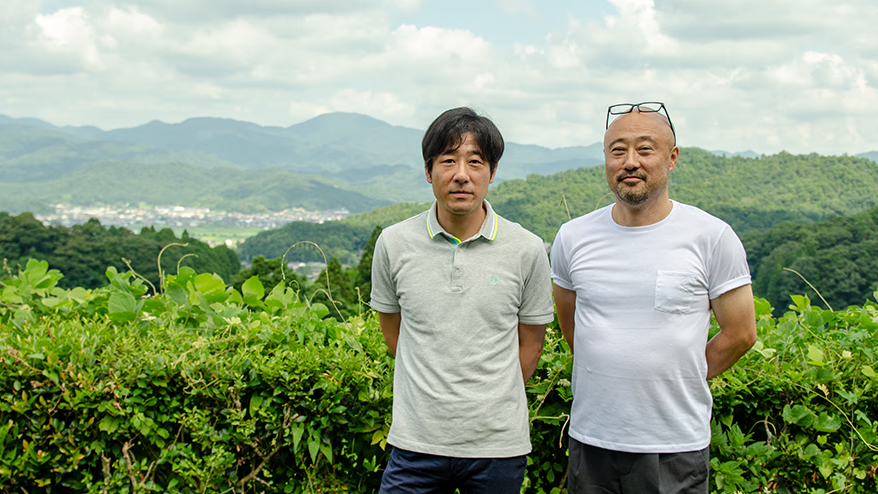モノサスとつながりのある方それぞれの「ものさし」をうかがう、めぐるモノサシ。京都府北部にある与謝野町で新たな町づくりに尽力する一般社団法人 PLACE 代表の有吉寿和さんと高岡洋輔さんにお話をうかがう後編です。
与謝野町は絹織物「丹後ちりめん」の一大産地であり、お米や野菜などの農業がさかんな場所。お二人は、町にあった醤油倉庫をリノベーションした「nest」を拠点に「人と人が出会う=可能性が生まれる」を掲げ「よさのみらい大学」の運営をはじめ、与謝野町の新たな魅力が生まれる活動をサポートしています。
-
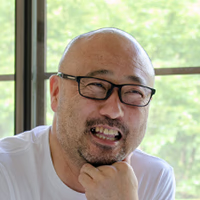
-
有吉寿和さんプロフィール:
(有)アリアソシエイツ代表取締役・一般社団法人 PLACE代表理事。
1968 年京都府与謝野町に生まれる。
京都精華大学芸術学部卒業後祖父が興した有吉家具店に入社。
2005 年有限会社アリアソシエイツとして法人化、2012 年家具建具製作工場開設。
2015 年一般社団法人PLACE設立、地域づくりを事業化するため挑戦中。
-
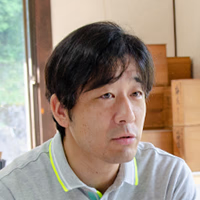
-
高岡洋輔さんプロフィール:
(株)高岡建材代表取締役・一般社団法人 PLACE代表理事。
大学卒業後、不動産会社にて営業のノウハウを学ぶ。 その後、故郷の与謝野町に帰郷。
27才で先代より木材建材販売業である㈱高岡建材の代表に就任。
2015年に空間資産を活かし人が集う場づくりをすべく新たに(一社)プレイスを設立し共同代表に。 日々奔走中。
昨年につづき、今年も夏から秋にかけて Food Hub Project(以下、フードハブ)支配人の真鍋が よさの未来大学で講座をさせていただくことになりました。真鍋は四国の神山町で、お二人は与謝野町で町づくりに取り組むという同じ軸をもちます。
前編では、お二人がどうして生まれ育った町、与謝野にUターンして町づくりに取り組むことになったのか、町づくりへの思いの根っこをうかがいました。
後編では、 講座準備のために与謝野町に美味しいものを探しにきた真鍋が、町の食文化や町づくりの今後についてお話をうかがいまいました。
(インタビュー構成:大村陽子)
大江山から野田川、そして阿蘇海へ。
水系のある与謝野町の食文化のルーツは?
真鍋
よさのみらい大学に呼んでいただいて、今回の講座では昨年よりも深く町にはいる感じになると思います。今回、与謝野町の農家さんなど、作り手の方をめぐっていますが、町独自の食文化がどんな風に残っているのかが、まだつかめていなくて。
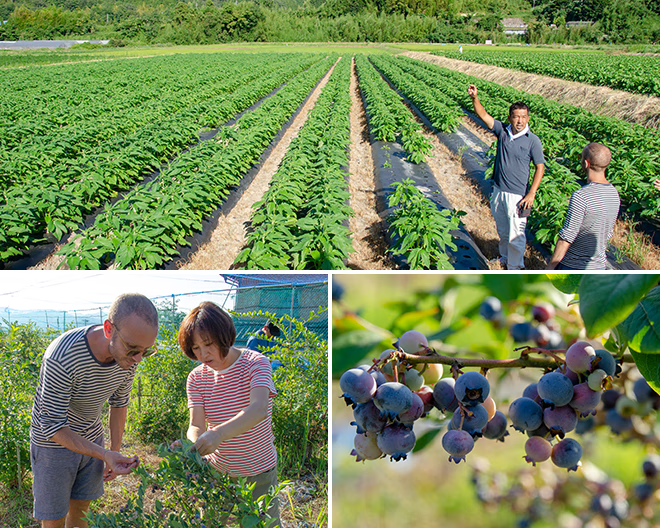
7月末、翌月のよさのみらい大学の講座に向けて与謝野町にある農家さんをフードハブメンバーで巡りました
でもどこかに絶対あるはずなんですよね。ちりめんの織物で栄えた旦那衆がいて、そこで旦那衆ってどこかにお金を落として、食文化が栄えていくという…
有吉さん
それは祇園だったり、京丹後とかかな。
真鍋
町の外になるのか…。
与謝野町は、いつ合併して与謝野町になったんですか?
高岡さん
12年前に、岩滝町と野田川町、加悦町の3町が合併して、今の形になりました。
有吉さん
大江山を水源とした野田川の流れが阿蘇海に注ぐという一つの水系でつながった町なので、理にかなった合併だと思っています。
真鍋
なるほど。ちょっと話がずれるんですが、フードハブって、各水系ごとにあっていいと思っているんです。
日本の食文化や、町の形成って水系ごとに発展してるはずなんですよ。この与謝野町もそういう形状をしてるなと思って。上からみると山があって平地があって海に注いで、と完璧。
有吉さん
高いところで獲れるお米は美味しいしね。
真鍋
水が綺麗で、温度差があるほど、美味しくなりますよね。
そういった水系を軸に文化が栄えるなかで、お金がある人たちが食文化を作っていくと思うんです。
有吉さん
宮津の三上家や、与謝野のちりめん街道にある江戸から明治時代にかけて栄えた尾藤(びとう)家はすごく豊かで。鉄道も織物のために引いたくらいですから。産業も活発でお金ももうかって、美味しいものを食べてたはずだけど…。
地道に農業だけで暮らしてきた町ではなくて、畑をしてたけど、織物がもうかるとなって機(はた)織りをやりはじめる人が多かったんですよね
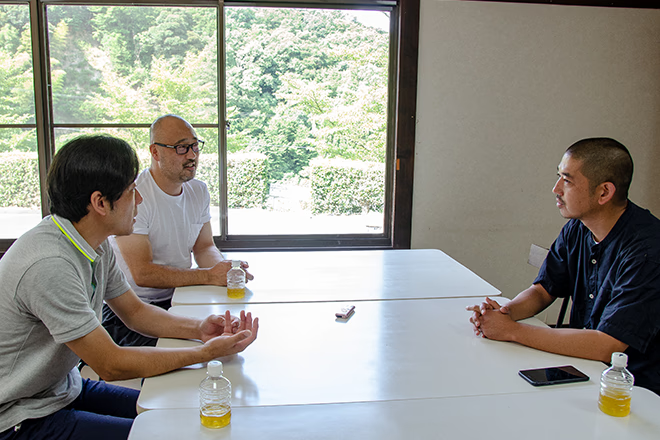
(左手前) 高岡さん(左奥) 有吉さん(右)真鍋
高岡さん
そのもうかり方も半端なかったと聞いています。
有吉さん
ガチャって織ったら一万円みたいな世界だったから。与謝野独自の食文化…なかなか思いつかないよね。
高岡さん
機織りで忙しいから、お昼はとにかく子どもらを15分で食べさせて自分たちはもう簡単に、という感じだったのかな。
真鍋
豊かになって町が栄えると、料理人を連れて来てお店を作る。そこで旦那衆が遊ぶ、みたいな形が町が発展する過程であると思うんです。そういう文化はなくはなかったのかな?
有吉さん
となりの宮津市は、花街がすごく栄えたと聞きますね。
高岡さん
北前船の時代は、祇園よりもちょっと高いっていう時代があったとか。
昨日もフードハブの料理長の細井さんに郷土料理を聞かれて、全然思いつかなかった。
有吉さん
でも、お米は、昔から食べてる基準が高くて。外食してお米を食べたら、これ食べられんわってことがかなりあるんですよ。
真鍋
子どもたちも?
有吉さん
子どもたちもそうですね。
高岡さん
素材は豊かにあるんです。
真鍋
新しく作っていくというのもありますね。
有吉さん
そういえば、阿蘇海にクロクチというハマグリより美味しい貝がいて、小さいころは普通に食べてましたね。
高岡さん
海が変わっていなくなったんですよね。
昔から愛されていた食を原点にすると、
山も海も変わっていくかもしれない
真鍋
クロクチはいなくなってしまったんですか?
有吉さん
昨日も山の手入れをしている人と話をしてたら、山があかんと。水自体の不純物がなくなっていて、山からのミネラルがないから貝もいなくなったんだと思うんです。
木の間伐もされてなくて、山にはいる人がほとんどいない。そういうことを言いながら、自分が家具屋で…。
高岡さん
うちが材木屋なんで考えていかないといけないね、と言っています。
真鍋
山を守っていく必然性はあるということですね。
高岡さん
そうですね。もともと山から木を切り出していた山師からうちは創業して、山で切ったものを都心に搬出する事業でずっとやってきていました。
僕が山にはいってやるというよりも、行政に提案したりして、山を守っている人たちをどうサポートするか、どういう風に支える仕組みをつくるかを考えていきたいと思っています。
少し話が飛びますが、神山は杉が特産ですが、神山町産とうたったりはできるんですか?
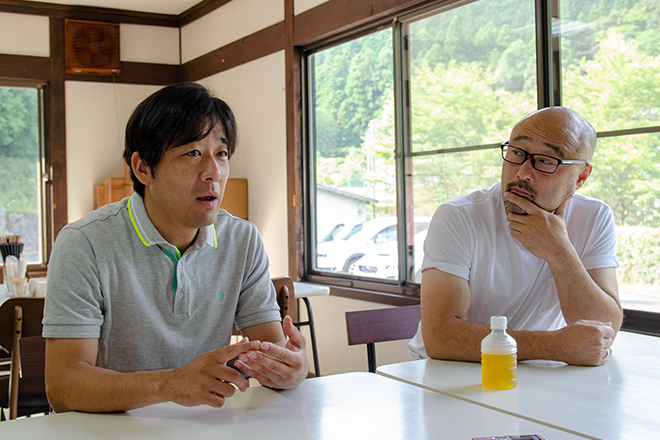
真鍋
神山産と認定したりしてますね。
高岡さん
それがすごいというか。小さい自治体で町産材まで認定してるところって多分京都ではないんです。府内のどこで伐採しようが、京都府産。
真鍋
神山は町産材の認定はしていますね。割り箸にも神山杉っていれてます。
林業活性化協議会というのが神山にはあって、その人たちが多分外部の団体と役場を絡めてそこで認定していると思いますね。
高岡さん
それはどんな木材が指定になっていますか?
真鍋
基本は杉です。
高岡さん
用材としては?
真鍋
建築がメインかな。神山には、地域内経済循環を基本にするという考えがあって。それを軸にするのでわかりやすい。 町内の集合住宅の事業で、建てるときは町内産の木を使いました、というのではなく、認定制度もつくって、動いてる。
でも製材所からそういうことを働きかけるって理にかなっていると思います。
高岡さん
そうですよね。京都府はなかなか難しいのが現状ですが、町産認定などができるようになったら、大きく変化していきそう。
真鍋
与謝野町産材の認定があって、地域内で循環させる。みんながハッピーになれる仕組みですよね。
有吉さん
そうやって、与謝野の山にはいっていったら、多分、海もよくなる。クロクチも復活するかもしれない(笑)
高岡さん
でも、ほんとにそうですね。
真鍋
山から海まで。そういうのを軸にするのはおもしろいですよね。スケールが壮大ですけど。
有吉さん
壮大だから結構大変。でもやっている人はいるんです。「三四の会」って言って、頑張って山にはいって間伐して整備してくださる方が。
高岡さん
昨日はその人たちのところに行かせてもらったんです。
有吉さん
彼らも70代とか60代後半なんで、興味をもってやってくれる若い人たちをみつけたいんだけどそれがなかなか…。
真鍋
そうですよね…。阿蘇海で採れていたというクロクチはどんな貝なんですか?
有吉さん
めっちゃ美味しいんです。牡蠣とアサリとハマグリを足したような味。
真鍋
全然想像できないけど、美味しそう!
有吉さん
アサリの出汁感と、牡蠣のミルキーな中身、あとハマグリの肉厚さを足したような感じ。炊いても焼いても美味しい。復活したら、オイスターバーならぬ、クロクチバーができるかも。レモンを絞って、粗塩とかかけたらめちゃくちゃうまいよね。そんな食べ方、今は獲れないからしたことないけど。

おにぎりくらいの大きさのものもあって、10数年前までは、阿蘇海沿いの、nest のある岩滝の人のところに行ったらたくさん食べられたんです。食べ方は味噌汁が多いかな。バーベキューに行ったら焼いて食べたり。あのあたりの人はいつも普通に食べてたんだと思います。
真鍋
でもいなくなったんですね。
有吉さん
もう獲れない。天橋立でも獲れたんですよ。泳ぎに行って、足でがーってやって足指ではさんで獲る。アサリ掘りに近い。
真鍋
有吉さんより上の世代はみんなその美味しさがわかるんですよね。
多分、地域で支持されるプロジェクトってそういうのが原点だと思うんです。
復活するって話になったら、みんな応援しようという気持ちになって。
「森をなんとかしないと」って言っても、なかなか現実味がない。
でも、クロクチみたいに、みんなが知ってる口にはいるものをちゃんと育てるために、森をちゃんとする。そういうみんなが感情移入できるものが現実を変えていけると思うんです。
山から海という壮大な話なので、相当、ハードル高いですが、面白い研究者とかがきっといるはず。
でも、会話してるとでてくるんですよねクロクチみたいな話が。
皆さんのなかに、ちゃんとある。
高岡さん
昔はたくさん食べてたけど今はなくなくなったものとか?
真鍋
そうですね。神山もすごく食文化があるようで、飲食店とかは多くはないんです。でも地域のお母さんたちのなかに眠ってる、食の力はすごいある。それをいかになくさないようにするかが大切だと思っています。
有吉さん
そういえば、岩滝の方に行ったら「てっぽう」がありますね。
真鍋
「てっぽう」ってなんですか?
高岡さん
ごはんにしょうがとしょうゆとゴマをふって、混ぜてにぎったものです。
有吉さん
うまいんですよ。
真鍋
しょうがはどういう状態ではいってるの?
高岡さん
しょうがはすりおろして。すごく美味しいんですけど、昔はお葬式が家であったので、僕の小さいころはまだ食べてました。近所のおばちゃんが、味噌汁と、「てっぽう」をつくってくれて。
真鍋
あるじゃないですか、郷土料理が!
有吉さん
商工会の青年部で、「てっぽう」をイベントのときにいっぱい作って売ったら瞬く間に売れましたね。
高岡さん
もちもいいんです。お葬式だと食べる時間が違ったり、持ってかえったり。うちの親父が死んだ時は家でお葬式をしたので。でも今は家からするお葬式はないし。こうやって消えていった食事はかなりあるでしょうね。
真鍋
食べてみたいなぁ。作れる人はまだいますよね?「ようつくりよったわ」っていう、昔から作ってきた人につくってもらいたいですね。
高岡さん
もちろん、いると思います。かまぼこと味噌汁と「てっぽう」。これは子どものころ食べていたって記憶にある。美味しかったなぁ。
真鍋
多分もっとあると思う。地域によっての細かい食の話はいっぱいあると思うんですよ。
地域ごとに。行政区域を3つにまたがってたから。
まだ見えない未来の人を考え、
今の行動を選択する大人がたくさんいる町
ここで、インタビューをしていた宿、かや山の家に宿泊されていたお二人のお知り合い、矢島里佳さんが、京都出発前にあいさつをしてくださいました。
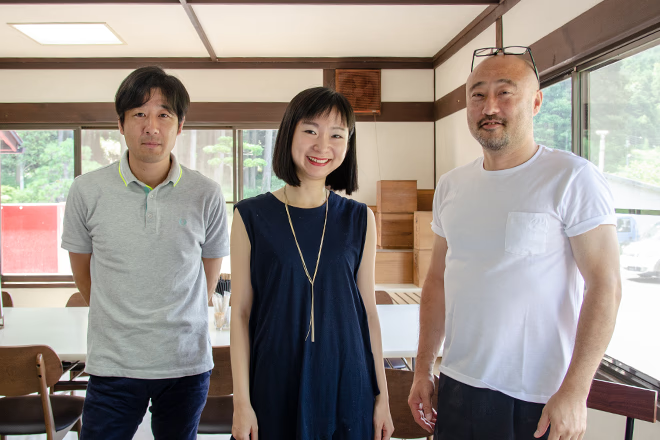
真ん中が矢島さん
矢島さんは、日本の伝統を次世代につなぐ会社「和える」の代表取締役を務めていらっしゃいます。また、京都のラジオ局・a ステーションで、京都の若手職人さんなどを紹介する「Artisan's talk」(毎週金曜日の朝 6:00〜6:55)という番組を持たれています。与謝野町にも頻繁に通われていて、この日は与謝野町の伝統産業「丹後ちりめん」の職人さんを番組で紹介されるそう。そんな矢島さんに、お二人の印象をうかがいました。
矢島さん
お二人は、自分の利益のためとか会社の利益のため、という次元を超えて物事を考えていらっしゃいます。
次世代の人たちのために今、自分たちに何ができるか、ということを楽しみながら活動されているので、ご一緒しているとワクワクします。まだ見えぬ未来に対して想像力を掻き立ててくださるお二人なのです。
いかに、未来を見ようとする大人がたくさんいる町か。それが絶対、これからの時代に残っていく魅力的な田舎の条件だと思うのです。
常に、遠い未来の人のことを考えていたら、結果、今の自分たちにとっても良い行動を自然とすることになります。お二人もそうですし、他にもこの町には未来を見据えた上で活動されている大人がたくさんいらっしゃる。これは私が与謝野町に通っている理由の一つです。
有吉さん・高岡さん
いいこと言うね(笑)
真鍋
すばらしい。
高岡さん
確かに、彼女は与謝野によく通ってきてくれていますね。
矢島さん
また4日後に、こちらに帰ってきます!
真鍋
ありがとうございました。
矢島さんから未来の話がでましたが、今回フードハブも講座をさせていただくよさのみらい大学。町の委託を受けて運営されていますが、どういう活動なのか改めてうかがってもいいですか。
高岡さん
与謝野で一流の人の話を聞く機会や、学ぶ機会が圧倒的に都心にくらべて少なかったんです。最新のものを学べる環境をつくって町の人に喜んでもらえるようにしたい、というのがよさのみらい大学のはじまりです。
現在、リベラルアーツ、地域づくり学部、与謝野ブランド戦略ビジネス学部と三種類のコースに別れています。ここで学ぶことが最先端、となることが理想で、各界の一流の人に来てもらっています。
一流の人に来てもらっている価値が、もしかしたらまだ町の人には伝わっていないかもしれません。でも一度来てもらって、その良さを体感してもらう。そういった体験のなかから、町からすごい人が生まれてくればいいな、と願っています。
与謝野で学んだ人が世界に出ていく。逆に世界から与謝野にくる。大きな話ですが、食の分野で来てくださっているレベルを考えるとできるんじゃないかと思っています。そこは、目指したいし、そういう人材が与謝野にもいるはずだと思っています。
埋もれてしまっている人を僕らもワクワクしながら発見したい。才能あふれる人はたくさんいると思うんですが、眠ってる人もたくさんいる。だからこれからが楽しみなんです。
真鍋
僕もがんばります。
有吉さん
一流ということばが適切かは分かりませんが、僕らの考える、一流の人を呼んでいます。やっぱり世界的に考えてもこれはすごい、頑張ってる、かっこいいねと思う良いものをみんなに学んでもらいたい。
田舎に足りないのはやはりブレーンだし、考え方。いろいろな面でまだ井の中だと思っていて、井の外ので活躍してる考え方や思想をもつ人に来てもらって、この場所でミックスしていきたいと思ってます。
よさのみらい大学では、講師と参加者が交流する時間を設けているんです。なので、自然と僕らが仲良くなりたい人をお呼びしています。僕らが一番楽しんでいる事業でもあるんです。
真鍋
今回、フードハブも講座をもたせてもらうんですが、気をつけないといけないと思っているのが、結局「つづけていける関係性を残せるかどうか」だと思っています。
呼んでいただいたから、何か投げかけたり、偉そうなことだけ言って帰るのは、町にとってはよくない。それはフィールドハックの反省点です。関係性が小さく残ってはいるけど、つながってよかったよね、というレベルだとちょっと違うのかもしれない。
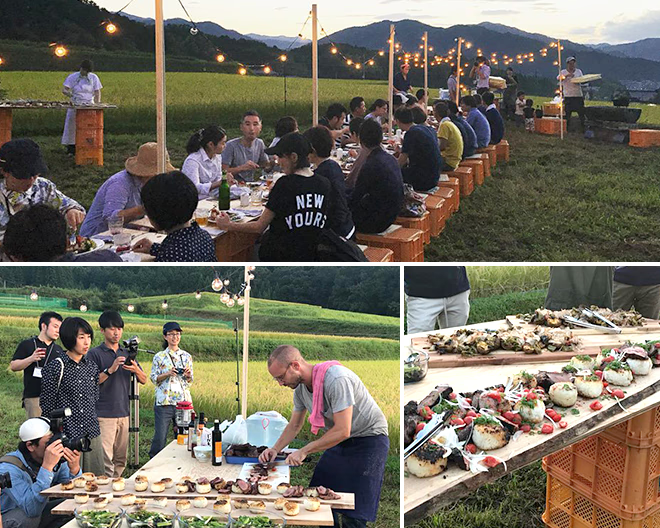
8月末に行ったフードハブの連続講座では、与謝野の食材を100%使い、田んぼのなかでのディナーを実施しました
有吉さん
僕らも、「継続が力」なので、やっぱり学ぶことを続けていきたい。同じ話でも、去年聞いたのと、今年聞いたのではやっぱり感じるところも違う。なので、同じテーマを同じ人に翌年もしてもらうというのが講座のなかには必要です。
自分自身も咀嚼して伝えられるようになるまで、結構時間がかかるので。
フードハブのことは必ずやらないといけないと思っていたので、昨年につづいて今年も来ていただくことにしました。町づくりのことや、健康のことなどは継続していく必要のあるテーマだと思っています。
こうやって続けていくことで、町の人にも運営はPLACEじゃないとだめだよねと思ってもらえるようにしていきたいですね。
モノサスの印象は?
真鍋
モノサスには「ともに生きていきたい人たちと働く」という言葉があるんですが、それはやはり、関係性をつづけていくという意味なんです。モノサスにどういう印象を持たれているかを最後に聞いてもいいですか?
有吉さん
代表の林さんと飲んだりするし、何回も会ってますが、林パワーじゃないけど、みんなやっぱりパワーがあると感じます。僕は ITの会社の人って、コミュニケーションが苦手な人が多いのかと思ってたけど、みんなフレンドリーで自分を出してる人もいる。なんだか近いなと思って、親近感がある。Web サイトも親近感があるし、フードハブをやることに決めた社長がすごいなと。
真鍋
すごいというか、変わってますよね。
有吉さん
変わってる。だから、ものさしがちがうなと思って。一緒にいることで、いつもちょっと、あ、これ、もらったということがあって、勉強させてもらってます。
高岡さん
普通、IT の企業は都市にあって、お金が目的だったり、上場が目的だったりして、売り上げを上げて、いいビルにはいって…もちろん、そんな会社ばかりじゃないですが、そんなイメージが先行しがちです。ですが、そういうエリアの人が極端にまったく違う分野にふれて、徳島で農業を真剣にやるという。なんでそういう考えに至っているのか、すごく興味があります。
神山の味を次世代に残していこうという思考回路がどこで生まれたのか。
本業のITと地域の食文化を再生させるフードハブの活動のどちらがミッションなのか。ミッションがどこにあって、どこにいきつこうとしているのか。答えがあるのかわかりませんが、そこに興味があります。
真鍋
答えはなんとなくあってけっこうシンプルなんです。改めてお答えできたらと思います。今回はお二人の生い立ちから聞けたのがとてもよかったです。ありがとうございました。
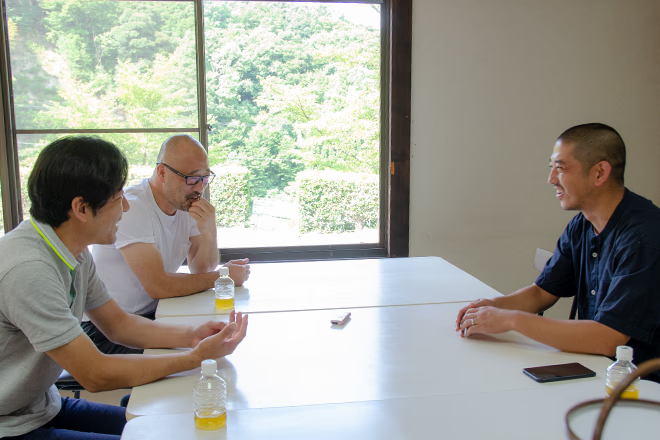
有吉さん・高岡さんへ
高岡さんからの最後の質問について、
答えにはなってないと思うのですが、私なりの考えを書けたらと思います。代表の林は、モノサスには「ミッション」がないと言います。どうやら集団をひとつの方向に向けて導きすぎるのはどうか、と思っているようです。それよりも、それぞれの多様な「ものさし」を育てるということに興味があるようです。多様な「ものさし」は、多様な「事業」とも言えるのかもしれません。
彼はよく、モノサスの事業を通じて、お金の「稼ぎ方」と「使い方」の両方のトレーニングをしていきたいと話します。別に、お金をたくさん稼いで、たくさん使う(お金でなんでも解決する)ことだけが、イコール幸せということでもどうやらなさそうだ、「そこそこ稼いで、上手に使う」ということでも、幸せや豊かさが得られるんじゃないか。これをみんなでどうやるか、ということをモノサスという会社組織を通じて実験し続けているんじゃないかと思います。なので、稼ぎ方と使い方の選択肢を増やすために、タイに事務所をつくったり、神山にサテライトオフィスをつくったり、副社長が実家の周防大島に引っ越して、サテライトオフィスを作ったりしています(どこも生活費が安い)。ここからモノサスにとって大事になってくるのが、それぞれの拠点で「何を」やるのか、ということになります。
神山でのフードハブ・プロジェクトは、その実験の第一弾と言えるかもしれません。
林の言うお金の「稼ぎ方」と「使い方」を、私なりに解釈して「働き方」と「暮らし方」と言ってるのですが、つまるところ人生は、この2つ(働き方と暮らし方)を豊かにするためにあるんじゃないかと思っています。その中で、モノサスは、東京を拠点に「働き方(稼ぎ方)」に軸足におき、フードハブは、神山を拠点に食べることを中心に「暮らし方(使い方)」に軸足をおいて活動していることになります。フードハブの合言葉の「地産地食」は、「何をどう選択して食べるか」という話でもあるので、お金の使い方でもあるし、暮らし方の話であるということです。
先日、林が「経済合理性」と「美学」の話をしていたのですが、一般的にビジネスは、経済合理性のみを追求していけばある程度の成功は見込めるが、そこにそれぞれの人の「こうしたい」みたいな美学が介入して、往々にしてうまくいかなくなっていると。しかしながら、フードハブ(≒私)は、経済合理性が一切なく、逆に「美学」しかないと。
この話は、まちづくりの話にもつながると思っているのですが、今の世の中は、「経済合理性」ばかりを優先させ、みんなが「美学」を忘れてしまっている、または押し殺しているように感じます。「美学」ってつまるところ、「超」面倒くさいけど、たくさんの人が「本当は」やったほうが良いよねと思っていることを徹底的にやる、ということでもあると思っています(特に食の文脈においては)。まちづくりに関しては、多くの場合、税金を使ってやるんだから、もっともっと「美学」を追求してやればいいんじゃないかと思っています。(経済合理性がなさすぎて続かなかったら意味ないんですが…大汗)
有吉さんと高岡さんのお二人からは、私たちの考える「働き方」と「暮らし方」に近いものを、みんなで共に作り上げようとする大きなエネルギーを感じます。それは、町で行き交うたくさんの知り合いがお二人に話しかけている雰囲気からも伝わってきます。与謝野という町を軸に、お二人なりの「美学」(超面倒くさいことw)を、これからも徹底的に追求されていくのが楽しみでなりません。引き続き、よろしくお願いいたします。
真鍋 太一
